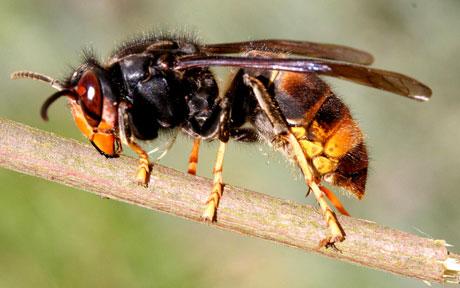
The bee-eating hornets, instantly recognisable by their yellow feet, are rapidly spreading round France and entomologists fear that they will eventually cross the Channel and arrive in Britain.
Hundreds of the insects attacked a mother on a stroll with her five-month-old baby in the Lot-et-Garonne department, southwestern France, at the weekend before turning on a neighbour who ran over to help. The baby was unharmed.
They then pursued two passers by and two Dutch tourists on bikes. The victims were treated in hospital for multiple stings, which are said to be as painful as a hot nail piercing the skin.
In the same week, a cleaner in local primary school came under attack after disturbing a hornet nest hidden in the ground.
The Vespa velutina, which grow up to an inch in length, is thought to have arrived in France from the Far East in a consignment of Chinese pottery in late 2004.
They first settled in the forests of Aquitaine, but quickly fanned out to surrounding areas, thriving on rising temperatures linked to global warming and the lack of indigenous predators.
Comment: "thriving on rising temperatures linked to global warming"
The mindlessness of global warming shows up everywhere now. It causes alpacas to freeze and bees and hornets to thrive.
A fine example of mind programming!
Denis Thiery, an Asian hornet specialist at the French National Institute for Agricultural Research, said there was nothing to halt their spread.
"From one nest discovered in 2004, there were 2,000 in the Bordeaux area in 2007. Today there are probably several thousand in surrounding departments," he said.
"According to our studies, they are able to settle in 50 per cent of the country. The European hornet is no match for them, with only a few hundred individuals per nest compared to several thousand for the yellow-footed hornets. They do sometimes fight, but it's a losing battle," he told the newspaper Le Parisien.
As a knock-on effect of the invasive species, the European hornet has become more aggressive, due to a lack of food.
The hornets are just as at home in cities, and favour building their football-shaped nests in sewers, where they have easy access to food and water supplies.
Local authorities in the tourist region of Lot-et-Garonne have issued a statement urging people with bee allergies to be "extremely cautious".
"Never attempt to destroy an Asian hornet nest yourself but call on specialist organisations, as this species charges in a group as soon as it feels its nest is threatened."
Anyone stung should dial 15 for the emergency services in case of an allergic reaction.
Besides the risk to humans, the hornets have decimated France's already dwindling bee population.
Squadrons of the insects hover over hives and pick off hapless honeybees in mid-air. A handful can destroy a nest of 30,000 bees in just a couple of hours.
In Asia, honeybees form a ball of workers around the intruder and kill it by heatstroke. But in France, the technique appears to have no effect.
Beekeepers suspect that the creatures are also massacring other indigenous insect species. "Nobody can say what damage the Asian hornet has done outside of our hives. What is certain is that last autumn there were less insects than before," said Richard Legrand, a keeper in Bergerac.
Entomologists in Britain have said that the species could cross the Channel. "You would expect it to move up France slowly, and there is no reason why it shouldn't reach the UK," said Stuart Hine, manager of the Insect Information Service at London's Natural History Museum.
But he added: "The Channel is still quite a good barrier. There is no need to panic."



Reader Comments
to our Newsletter